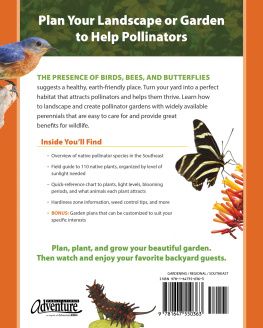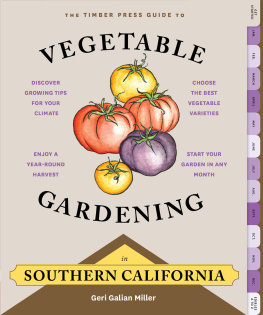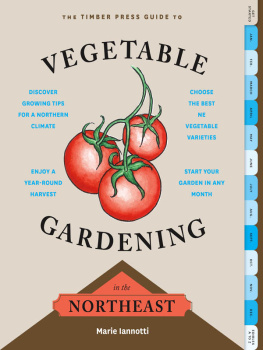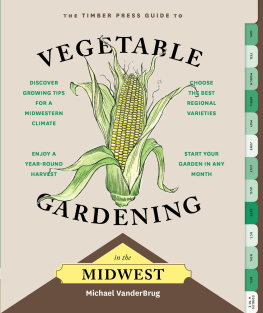THE TIMBER PRESS GUIDE TO VEGETABLE GARDENING
in the
SOUTHEAST
IRA WALLACE
Timber Press
_________________
Portland London
To my grandmother, Estella, and my daughter, Raphael, who both loved eating fresh from the garden every day.
Copyright 2013 by Ira Wallace.
All rights reserved.
Chapter opening illustrations by Kate Giambrone and Julianna Johnson
All other illustrations Julia Sadler
Published in 2013 by Timber Press, Inc.
The Haseltine Building 133 S.W. Second Avenue, Suite 450 Portland, Oregon 97204-3527 timberpress.com | 6a Lonsdale Road London NW6 6RD timberpress.co.uk |
Book design by Kate Giambrone and Julianna Johnson
Library of Congress Cataloging-in-Publication Data
Wallace, Ira.
The Timber Press guide to vegetable gardening in the Southeast/by Ira Wallace.1st ed.
p. cm.
Guide to vegetable gardening in the Southeast
Includes index.
ISBN 978-1-60469-573-1
1. Vegetable gardeningSouthern States. 2. VegetablesSouthern States. I. Title. II. Title: Guide to vegetable gardening in the Southeast.
SB321.5.S74W35 2014
635.0975dc23
2013013712
TABLE OF CONTENTS
Preface
Vine-ripened tomatoes, succulent figs, crisp winter salads, corn on the cob, and sweet braised greens are just a few of the fresh-from-the-garden delights awaiting gardeners in the Southeast. Working with long, hot summers and mild, uneven winters, southern gardeners from Thomas Jefferson to Barbara Kingsolver have feasted abundantly in every season. Every year at the Heritage Harvest Festival at Monticello, a celebration of heirloom varieties, local food, and sustainable agriculture at Jeffersons mountaintop home, I have the privilege of meeting hundreds of eager gardeners. The bountiful harvest on display at the festival is an inspiration to new gardeners. With a little planning and knowing how to make the right choices for a southeastern garden, even beginning gardeners can have that abundance throughout the year.
I often run workshops on year-round gardening and growing garlic and perennial onions at the Monticello and Mother Earth News fairs, and afterward, eager participants frequently ask if I have a book. Finally, this is my offering, sharing what I have learned about year-round food growing in over 40 years as an organic gardener and over 20 years as an advocate and producer of heirloom organic seeds at Southern Exposure Seed Exchange (SESE) in central Virginia. Our motto at SESE is Saving the Past for the Future; we strive to preserve the knowledge that lets farmers enjoy abundant harvests without chemical fertilizers and pesticides. Our farm is certified organic and I am committed to keeping our spot of earth healthy and productive. Throughout this book, I have shared the information youll need to make your own garden equally rich.
My gardening roots trace back to my grandmothers backyard in Florida where I grew up. We had something growing every month, although all I remember growing in late summer were black-eyed peas, okra, and sweet potatoes. That was the slow time, but it didnt last long. As soon as the weather started cooling off a little we went all out with greens, squash, peppers, tomatoes, and beans. Winter brought on lettuce, celery, and even more greens. I dont think I grew broccoli and other more refined members of the cabbage family until after I went off to college. But, boy, did we have some fine cabbages, collards, turnips, and mustards. These memories make fall and winter gardening special for me. Fall harvests provide fresh organic food just when it is most expensive in the markets and less available from local farms. And growing a fall garden is actually easier than summer gardening, once you get the timing down. In the July and August chapters, Ill go through the basics of summer planting for an abundant fall and winter harvest. I share the techniques and timing that work for us to start seeds in the heat.
In these hectic, modern times, many of you might feel that it is hard to find the time you need to produce your own food. Well, let me tell you that I struggle with having enough time myself. Its one reason that I am always looking for new wayslike creating no-dig lasagna bedsto make gardening easier. Gardening is still a lot of fun for me. I always make time to try out something new in the garden each year. This is how I find new and exotic tastes like Thai Red roselle for jams and refreshing drinks or delicious new-to-me heirlooms like Shronces Deep Black peanut. I have tried to share many of my favorite heirloom varieties for those of you who want to be able to save seeds as well as enjoy fine flavors. I have included basic seed-saving instructions for each of the vegetables in the Edibles A to Z section.
There are almost as many reasons for gardening as there are gardeners. But whatever the reasons, in the last five years we have seen the number of new gardeners buying our seeds increase by 10 to 20 percent every year and the attendance at the Heritage Harvest Festival at Monticello has quadrupled. The question of what is going into our food and where it comes from has led many of us toward local and organic food, and that excitement is only growing. And what food is more local than the food from your own backyard? Whether you are new to gardening or an old hand looking for tips, I hope this book will give you the tools and motivation you need to get gardening straight away.
Acknowledgments
I have been giving talks on gardening in the Southeast, writing articles, and contributing to the Southern Exposure Seed Exchange catalog for many years. But it took surviving a life-threatening operation for me to finally agree to write an actual book.
It was Timber Press, and especially Juree Sondker, who got me started. I so appreciate her encouragement and editing, plus that of Michael Dempsey, for keeping me on track and making this a much better book.
Thanks also to my gardening friends Pam Dawling, Cindy Conner, and Ken Bezilla, who shared their experience and their years of gardening records, and answered so many of my questions along the way.
I am especially grateful to Lisa Dermer, organizer par excellence, and Gordon Sproule, who both worked with me from the beginning, helping whenever I askedediting and offering insightful suggestions and personal encouragement whenever I needed them.
Thank you to all my friends and fellow worker/owners at Southern Exposure Seed Exchange and Acorn Community Farm for supporting me in writing this book by taking on a lot of my usual work in our gardens and in the office.
GET STARTED

WELCOME TO THE SOUTHEAST

The climate in the southeastern states is warm and wet, with long, hot summers, high humidity, and mild winters with many rapid changes in temperature. Happily, gardening is a year-round activity in our region. The southeastern states covered in this book spread from the beaches of the Delaware and Marylands Delmarva Peninsula across the Appalachians to the edge of Oklahoma and all the states south of that line, including the acid soils of east Texas. Our definition of the Southeast largely mirrors the native range of the American holly. This area includes USDA climate zones 6, 7, 8, and 9, with small bits of zone 5 at higher elevations, plus a little zone 10 in middle Florida and southern Louisiana. We leave the special conditions in the tropical south where it never freezes and the hot, dry, alkaline soils of west Texas to another volume. Gardeners in southeastern Oklahoma and southern Ohio may also find this book a valuable resource.
Next page










